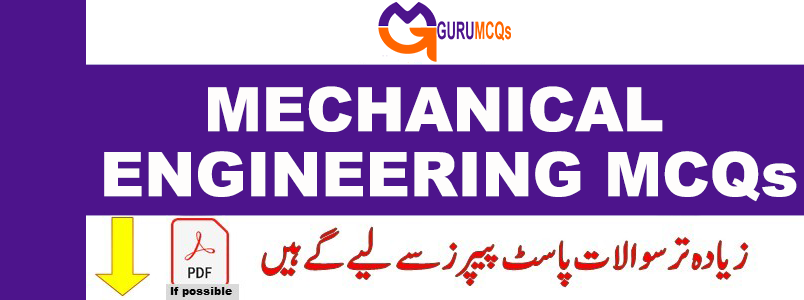
GuruMCQs.com provides all updated Mechanical Engineering Multiple Choice Questions (MCQs). The most frequently repeated mechanical MCQs section is frequently encountered in FPSC, PPSC, ETEA, NTS, Army, Navy, Air Force, educators, and various other competitive exams, as well as government and private job assessments. Most repeated mechanical engineering MCQs cover topics like Engineering Materials, Fluid Mechanics, Hydraulic Machines, Machine Design, Engineering Mechanics, Nuclear Power Plants, Steam Boilers, Engines, Nozzles, Turbines, Compressors, Gas Turbines, Jet Engines, Thermodynamics, Engineering Metrology, Heat Transfer, etc. Preparing with these MCQs can significantly contribute to your success in government job exams and interviews. Whether you are aiming to establish a career in engineering or seeking to enhance your existing skills, the Mechanical Engineering MCQs at www.gurumcqs.com serve as a valuable resource. Stay committed to regular practice and empower yourself with the knowledge needed to excel in your academic and professional endeavors.
**151. The condensing pressure due to the presence of non-condensable gases, as compared to that actually required for condensing temperatures without non-condensable gases:**
– **A. will be higher**
– B. will be lower
– C. will remain unaffected
– D. may be higher or lower depending upon the nature of non-condensable gases
– E. unpredictable
**152. The vapor compression refrigerator employs the following cycle:**
– A. Rankine
– B. Carnot
– **C. Reversed Rankine**
– D. Brayton
– E. Reversed Carnot
**162. The moisture in a refrigerant is removed by:**
– A. evaporator
– B. safety relief valve
– C. dehumidifier
– **D. driers**
– E. expansion valve
**153. In vapor compression cycle the condition of refrigerant is dry saturated vapor:**
– A. after passing through the condenser
– B. before passing through the condenser
– C. after passing through the expansion or throttle valve
– D. before entering the expansion valve
– **E. before entering the compressor**
**154. In vapour compression cycle, the condition of refrigerant is saturated liquid:**
– **A. after passing through the condenser**
– B. before passing through the condenser
– C. after passing through the expansion throttle valve
– D. before entering the expansion valve
– E. before entering the compressor
**155. An important characteristic of absorption system of refrigeration is:**
– A. noisy operation
– **B. quiet operation**
– C. cooling below 0°C
– D. very little power consumption
– E. its input only in the form of heating
**156. Vapor compression refrigeration is somewhat like:**
– A. Carnot cycle
– B. Rankine cycle
– C. reversed Carnot cycle
– **D. reversed Rankine cycle**
– E. none of the above
**157. Ammonia-absorption refrigeration cycle requires:**
– **A. very little work input**
– B. maximum work input
– C. nearly same work input as for vapour compression cycle
– D. zero work input
– E. none of the above
**158. One ton refrigeration corresponds to:**
– A. 50 kcal/min
– B. 50 kcal/kr
– **C. 80 kcal/min**
– D. 80 kcal/hr
– E. 1000 kcal/day
**159. A standard ice point temperature corresponds to the temperature of:**
– A. water at 0°C
– B. ice at – 4°C
– C. solid and dry ice
– **D. mixture of ice, water and vapour under equilibrium conditions under NTP conditions**
– E. mixture of ice and water Under equilibrium conditions
**160. In vapour compression cycle the condition of refrigerant is superheated vapour:**
– A. after passing through the condenser
– B. before passing through the condenser
– C. after passing through the expansion or throttle valve
– D. before entering the expansion valve
– **E. before entering the compressor**
